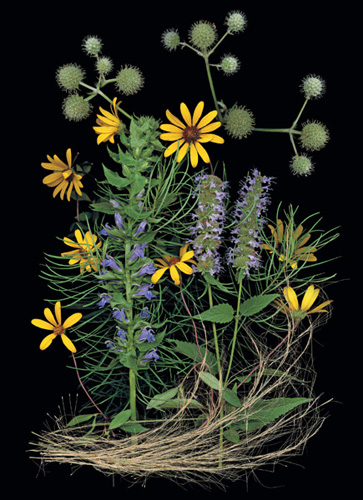
Subtle North American plants include yellow daisy Heliopsis helianthoides var. scabra ‘Summer Nights’, spiny buttons of Eryngium yuccafolium (rattlesnake master), the large blue-violet spire of Lobelia siphilitica, smaller Agastache foeniculum, and the soft Mexican grass, Nassella tenuissima*.

People seem drawn to open pastoral landscapes with gently rolling hills covered by shorn grass. I, too, find that beautiful. I suspect this to be a primordial attraction. In open land, we can see that no predators are hiding behind the scrub to attack and eat us.
However, I like the woods as well. The shadowy forest is a place that fairy tales tell us is filled with hidden dangers and evil spirits—left over from times when there might have been some peril. But we don’t have to respond to such inclinations, even if they are in our genes. We can create gardens in any style our climate will allow—be that pasture or forest; Japanese or Italian style; or even floating on water.
There are many ways to bring a sense of a place to the garden. You might create a strictly native planting—a noble pursuit. You could select diverse plants from around the world that fit the conditions offered by your landscape. But you can still build gardens in the style of other regions or countries.
I have to remember that “right plant, right place” is a valuable recommendation. It would be silly to try and grow tropical plants outdoors in Nova Scotia, although they might make a good seasonal container planting, and better, a Panhandle planting. That doesn’t mean that a bit of finessing is out of the question: After all, this is horticulture, and like agriculture, making adjustments like amending the soil is acceptable and often necessary.
Most of my property has very sandy soil deposited by the flooding river, but there is clay in one area. The clay stayed moist until rains stopped, and then it got brick-hard. I added compost and three-eighths-inch crushed rock and turned the clay over to a depth of twelve to eighteen inches: That worked. The clay holds moisture, but the gravel improves drainage. A south-facing seventy-foot-long low stone wall around the garden absorbs heat from the sun and radiates it to the plants, which helps me cheat the zone. This place in Zone 6 with forty-five inches of annual precipitation is rather Mediterranean in style with herbs like nepeta, lavender, and thyme.
Meadow species share a mixed border. Florida plants summer in containers, and waterside species grow along the edge of the canal that cuts across my island property.